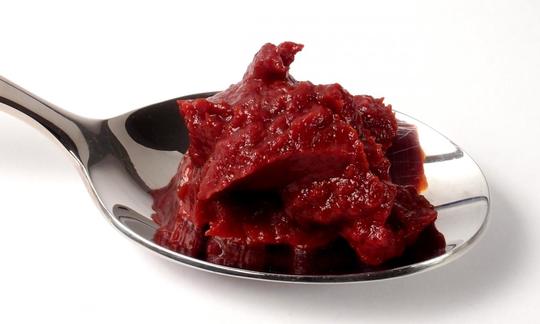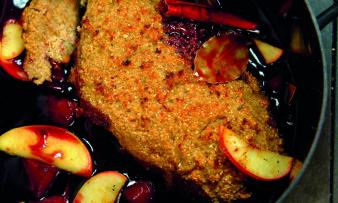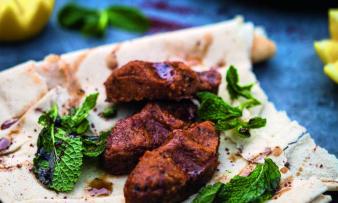Table of contents
Tomato paste, in Switzerland tomato puree Not only is it used to refine sauces and dishes, it is also used raw as a spread. Many supermarkets offer it organic and unsalted.
Use in the kitchen
Tomato paste is concentrated, preserved pulp from ripe tomatoes in the form of a paste. Because the pureed pulp is boiled down, tomato paste is not a raw food. Is tomato paste vegan? The paste is, however, vegan.
Tomato pastes differ in terms of their water content (or dry matter). There is single-concentrated, double-concentrated and triple-concentrated tomato paste. Single-concentrated tomato paste has the highest water content at around 80% (14-22% dry matter). Double-concentrated tomato paste has a water content of around 70% (28-30% dry matter). Triple-concentrated tomato paste is the most concentrated at around 60% water content (36-40% dry matter) and therefore has the most intense flavour. 1,2 In Switzerland, the minimum dry matter content is set at 12% for single-concentrated, 24% for double-concentrated and 36% for triple-concentrated tomato puree. 3 Tomato paste with a higher dry matter content of 40% is sometimes also referred to as tomato paste.
Very ripe tomatoes contain a lot of glutamic acid and monosodium salt. 23 Heating and concentrating tomato paste reduces its acidity, but increases the amount of natural glutamate, which creates the "umami" taste.
You can find salted or unsalted tomato paste in stores. In this article we focus on unsalted tomato paste. Raw, it tastes slightly bitter and not noticeably like tomatoes. However, the fruity tomato flavor comes out when cooked.
Can you eat tomato paste raw? Tomato paste is primarily used in cooking, but it can also be eaten raw. It is recommended pure or spiced up (e.g. with garlic, salt,pepper and herbs such as basil, thyme or rosemary) as a spread on bread, or mixed with soy yoghurt, vegan quark or vegan mayonnaise to make a dipping sauce.
Tomato paste is an indispensable ingredient in Italian cuisine, for example for refining, intensifying and thickening sauces, soups and casseroles. It can be used to make pasta sauces (e.g. vegan Bolognese), vegan goulash soups (e.g. with potatoes, carrots and red bell peppers) or curry soups. Tomato paste is also suitable for risotto, vegan chili sin carne, for marinating tofu or as an ingredient in a tasty dressing for salads or bulgur. The West African stew Mafé and the Spanish rice dish Paella (both of which can also be made vegan) are also refined with tomato paste. The following three dishes with tomato paste are recommended:
- Vegan Christmas roast with red wine plum sauce
- Lentil couscous balls with cumin
- Quince stew with potatoes and dried plums
Very finely sieved, highly concentrated tomato paste is also the basis for ketchup, which, in addition to the paste, consists of sugar, vinegar, spices and salt.
Making your own tomato paste
You can find out how to make your own tomato paste in the article " Homemade tomato paste ".
Vegan recipe for a tomato sauce
Ingredients (for 4 people): 2 onions (raw), 2 cloves of garlic (raw), ½ bunch of fresh thyme, 2 tbsp rapeseed oil, 4 tbsp unsalted tomato paste (organic), 800 g chopped tomatoes (canned), some oregano, salt andpepper.
Preparation: Peel the onions and garlic cloves and chop finely. Rinse the thyme and shake dry. Pick off the thyme leaves and chop finely. Put the rapeseed oil in a pan and heat. Sauté the onions and garlic for approx. 2-3 minutes until translucent. Add the tomato paste and fry briefly, stirring constantly. Add the chopped tomatoes and bring to the boil. Mix in the chopped thyme leaves and season with a little oregano. Simmer for approx. 10 minutes at a medium heat. Season the vegan tomato sauce with salt and pepper and serve with spaghetti, for example.
Vegan recipes with tomato paste (unsalted) can be found under the note: " Recipes that have the most of this ingredient ".
| Not only vegans or vegetarians should read this: Vegans often eat unhealthily. Avoidable nutritional errors. |
Purchasing - Storage
Tomato paste can be bought all year round in all supermarkets (such as Coop, Migros, Denner, Volg, Spar, Aldi, Lidl, Rewe, Edeka, Hofer, Billa etc.) and organic supermarkets (e.g. Denn's Biomarkt and Alnatura) - either in tubes, small tins or screw-top jars. Choose tomato paste in small tins or screw-top jars if you only need a little of the paste for a dish. If you use it regularly, tomato paste from a tube is more practical as it can be closed well and therefore lasts longer. The intensity increases from single-concentration to triple-concentration tomato paste.
Also pay attention to the product's ingredients list. Tomato paste is often found with salt. Seasoned versions are also available (e.g. with garlic and basil). Tomato paste occasionally contains additives such as citric acid or ascorbic acid as an acidity regulator.
The availability of tomato paste (unsalted) varies depending on the size of the store, catchment area, etc. Our recorded food prices for the DA-CH countries can be found above under the ingredient image - and by clicking on them you can see their development at various suppliers.
Storage tips
Tomato paste in tubes should be stored in the refrigerator after opening. This way it will last for several months. Make sure that the opening of the tube does not come into direct contact with your fingers or food so that germs do not get on it. Leftover tomato paste from cans should be poured into a screw-top jar to protect it from drying out and unwanted germs. It does spoil more quickly than tomato paste from tubes, so you should use up the leftovers quickly.
To test whether tomato paste from a tube is still edible, put a little on a spoon and check the sample visually for mold, olfactory for an unpleasant smell and finally taste for mustiness.
Ingredients - Nutritional values - Calories
Unsalted tomato paste contains 82 kcal/100g. With 0.47 g fat per 100g, tomato paste is low in fat. It contains 4.3 g of protein per 100g and 4.1 g of fiber per 100g. Of the 19 g of carbohydrates per 100g of tomato paste, 12 g are sugar (13.5% of the daily requirement). 4 The sugar content of tomato paste is therefore not to be ignored (especially for diabetics).
Tomato paste is rich in potassium when unsalted. 100 g of tomato paste contains 1014 mg of potassium (51% of the daily requirement). Potato starch and onion granules have comparable amounts. There is even more potassium in dried tomatoes (3427 mg/100g). 4
Unsalted tomato paste contains 4.3 mg/100g of vitamin E (36% of the daily requirement). A similar amount can be found in apple syrup (3.5 mg/100g). Hazelnut oil contains almost eleven times as much, at 47 mg/100g. 4
Tomato paste (unsalted) contains 22 mg of vitamin C (ascorbic acid) per 100 g, which is 27% of the daily requirement. This content is comparable to that of preserved guava nectar (21 mg/100 g). Regarding processed products, dried onions have significantly more of this vitamin, at 75 mg. 4
Which vitamins does tomato paste contain? Besides vitamin E and vitamin C, the most common vitamins in tomato paste are niacin (vitamin B3), vitamin K and vitamin B6.
The complete ingredients of tomato paste (unsalted), the coverage of the daily requirement and comparison values with other ingredients can be found in our nutrient tables. In the article Nutrients explained you will get a detailed insight into the topic.
Health effects
Tomatoes contain a variety of nutrients and bioactive compounds that can have a positive effect on human health. You can find out more about the health benefits of fresh, raw tomatoes in the associated article. The focus below is on the health aspects of tomato paste.
Is tomato paste healthy? Consumption of tomato products, such as tomato paste, promotes antioxidant and anti-inflammatory mechanisms. A 2012 Greek study examined the effect of supplementing the diet with tomato paste on endothelial function. 5 The endothelium, a thin layer of endothelial cells, lines the inside of blood vessels and serves as a barrier to tissue. It also produces substances (e.g. nitric oxide) that regulate the cardiovascular system, including blood pressure. 6 The results showed an improvement in endothelial function in a group of healthy people. However, further research is needed to determine the effects of long-term tomato product supplementation on endothelial function and the risk of cardiovascular disease. 5
A 2008 study examined the effects of tomato paste production (heat exposure and processing) on the antioxidants contained in tomatoes. The study found an increase in the antioxidant flavonoids, but at the same time observed a significant decrease in the antioxidants vitamin C and lycopene in tomato paste compared to fresh tomatoes. Since vitamin C is the most abundant antioxidant in tomatoes, the decrease in vitamin C was more significant, and the antioxidant activity of the study samples decreased slightly overall. Other studies also report losses of lycopene as a result of heat treatments. However, the results of other studies show increased levels of the carotenoid lycopene after thermal treatments and homogenization in juice and paste production. According to the study mentioned, the increase reported by other studies could be due to increased extractability during processing of the tomatoes. 7
Studies show an increased bioavailability of lycopene from tomato paste (compared to fresh tomatoes). 8 Is tomato paste healthy for the skin? Lycopene-rich tomato paste can protect the skin from acute and long-term photodamage (caused by UV radiation). This was also confirmed by an English study from 2010. Eating tomato paste can also prevent premature skin aging caused by UV radiation. 17 Should you eat tomato paste every day? If you want to increase your lycopene levels and avoid dietary supplements, you can try consuming a tablespoon of tomato paste every day. Other heated tomato-containing products or fruits such as guavas, rose hips, pink grapefruits and the Vietnamese gac fruit are also suitable sources of lycopene. 18
Dangers - Intolerances - Side effects
Does tomato paste contain sugar? Tomato paste naturally contains a relatively high amount of sugar (fructose). Is too much tomato paste unhealthy? Diabetics or people who want to avoid too much sugar should therefore use the paste sparingly. 9
Does tomato paste contain salt? Depending on the product, tomato paste can be salted. Check the ingredients list before use so that you do not oversalt prepared foods. 9 It is best to use unsalted tomato paste.
As in fresh tomatoes, tomato paste also contains histamines. 9 People with histamine intolerance cannot break down the biogenic amine sufficiently and suffer from various symptoms such as reddened skin, itching, digestive problems, dizziness or headaches. 10 Therefore, people with histamine intolerance should avoid eating tomatoes and their products. 9
Due to the possibility of metals leaching from packaging into the product, the Bavarian State Office for Health and Food Safety ( LGL) examined the levels of a selection of chemical elements in 27 samples of commercially available tomato paste from glass, cans and tubes in 2016. In most of the samples, the LGL was unable to detect any of the toxic heavy metals such as arsenic, lead and thallium. Measurable lead and cadmium levels were well below the permissible maximum levels. 1
Ecological footprint - animal welfare
According to a 2020 study by the Institute for Energy and Environmental Research Heidelberg, tomato paste has a CO 2 footprint of 4.3 kg CO 2 eq/kg. This is larger than that of fresh tomatoes (average 0.8 kg CO 2 eq/kg). 11
A 2023 study calculated the cradle-to-gate life cycle assessment of tomato paste production in Turkey. The study included the following aspects: CO2 footprint, potential for ocean acidification, eutrophication, human toxicity, ozone layer depletion and photochemical smog. The results of the study show that the largest contribution to the negative environmental impacts lies in the raw material supply phase, mainly due to the use of fungicides (for agriculture) and metal (for packaging). The energy required for agriculture and production processes also has a significant impact on the environment. 12 Tomato paste can usually be bought in jars or metal tubes. Both types of packaging have a negative impact on the environment: the production of jars is very energy-intensive and produces correspondingly high levels of emissions. In addition to a lot of energy, the production of aluminum requires the raw material bauxite, for the mining of which large areas (including rainforests) have to be cleared. In addition, aluminum production produces an intermediate product that is toxic to the environment, so-called red mud (contains iron and titanium oxides). If disposed of improperly, this is responsible for serious environmental problems. 19 Aluminum can be recycled after use, but this process also requires a lot of energy. 20 Ideally, you should make your own tomato paste, which saves you the environmentally harmful packaging.
Tomatoes for the production of tomato paste are also grown in dry, rain-poor regions such as California. This is a concern because the tomato fields have to be intensively irrigated. The water content of the tomatoes is then reduced again in the factories during the thickening of the paste using vacuum evaporation. 13 To produce 1 kg of tomato paste, 713 liters of water are needed, about three times as much as to produce fresh tomatoes (214 liters). 21
Worldwide occurrence - cultivation
The processing of tomatoes into tomato paste is a traditional method of preservation. 1 The process for producing tomato paste has its origins in Emilia-Romagna, a region in northern Italy. In the 19th century, a large number of Italians emigrated and thus spread the use of tomato paste. 13
China, Italy, Spain and the USA are among the world's largest exporting nations and Western Europe is considered the main importing area (as of 2021/22). 14
Possible confusion
Depending on the country, there may be terminological confusion. In Switzerland, the term "tomato puree" also refers to tomato paste. The dry matter content may be in the lower, simply concentrated range. In Germany, on the other hand, tomato puree is much more liquid; it is blanched, skinned, pitted, strained tomatoes that are not concentrated. 16
Tomato puree and tomato paste are also used in English. Both consist of peeled, pitted tomatoes, with a cooking time of several hours. However, they differ in concentration: puree is significantly thinner, so has a solids content (TSS = total soluble solids) of 8-24%. A tomato paste is said to be 24% or more. An extra heavy tomato paste with a TSS of over 38.5% can be compared to the "tomato paste" found in the DA-CH countries. 24 An international quality standard, CODEX STAN 57-1981, designates tomato concentrate with more than 8% TSS as such and distinguishes tomato puree from tomato paste from 24% TSS. 25
Industrial production
Ripe, sorted tomatoes are used to make tomato paste. These are washed before being mechanically peeled, chopped, cored and strained. The resulting mass is thickened using heat and vacuum evaporation and the water content is reduced to the desired concentration level (single concentration, double concentration, triple concentration). Finally, the tomato paste is placed in the intended packaging, such as tubes, cans or screw-top jars. 1,2,15
Further information
We could not find any legally defined regulation for the use of the terms tomato puree, tomato paste and tomato concentrate. Only the dry matter content of tomato paste is usually regulated. Although Germany has no legally binding specifications, it uses the standard commercial values of the " European assessment criteria for tomato ketchup (Code of Practice) ", and Italy has legally defined the same values. 22 In Switzerland, the Federal Department of Home Affairs (FDHA) issued a regulation on beverages in 2020.
Alternative names
In addition to tomato paste and tomato puree, it is also known as tomato concentrate and the even more concentrated tomato paste. In eastern Austria it is sometimes called Paradeismark (Paradeis = tomato).
The English name for tomato paste is tomato puree.
Bibliography - 25 Sources
| 1. | Bayerisches Landesamt für Gesundheit und Lebensmittelsicherheit. Ausgewählte chemische Elemente in Tomatenmark - Untersuchungsergebnisse. 2016. |
| 2. | Topagrar com: Warenkunde: Tomatenmark. 2018. |
| 3. | Verordnung des Eidgenössisches Departement des Innern (EDI) über Getränke (Stand 2020). |
| 4. | USDA United States Department of Agriculture. |
| 5. | Xaplanteris P, Vlachopoulos C, Pietri P, Terentes-Printzios D, Kardara D, Alexopoulos N, u. a. Tomato paste supplementation improves endothelial dynamics and reduces plasma total oxidative status in healthy subjects. Nutr Res. 2012;32(5):390–4. |
| 6. | Floxikon.doccheck com: Endothel. 2022. |
| 7. | Capanoglu E, Beekwilder J, Boyacioglu D, Hall R, de Vos R. Changes in antioxidant and metabolite profiles during production of tomato paste. J Agric Food Chem. 2008;56(3):964–73. |
| 8. | Gärtner C, Stahl W, Sies H. Lycopene is more bioavailable from tomato paste than from fresh tomatoes. The American Journal of Clinical Nutrition. 1997;66(1):116–122. |
| 9. | Oekotest de: Ist Tomatenmark gesund? Was Sie über die Paste wissen sollten. 2021. |
| 10. | Aha! Allergiezentrum Schweiz. Histaminintoleranz. |
| 11. | Reinhardt G, Gärtner S, Wagner T. Ökologische Fussabdrücke von Lebensmitteln und Gerichten in Deutschland. Institut für Energie- und Umweltforschung Heidelberg ifeu. 2020;1-22. |
| 12. | Üctug FG, Tekin Z, Dayioglugil Z, Ulusoy E, Oktaylar Keyik S. Life cycle assessment of tomato paste production: a case study. Pamukkale University Journal of Engineering Sciences. 2023:1-10. |
| 13. | Malet JB. Täglich Tomate. Globaler Einheitsbrei in Dosen. In: Le Monde diplomatique. 2017. |
| 14. | Tomatonews com: Trade: World trade 2021/2022 (May-April): Covid continues to have an impact. |
| 15. | Karakaya A. Özilgen M. Energy utilization and carbon dioxide emission in the fresh, paste, whole-peeled, diced, and juiced tomato production processes. Energy. 2011;36(8):5101–10. |
| 16. | Tomaten-welt de: Was ist eigentlich Tomatenpüree? |
| 17. | Rizwan M, Rodriguez-Blanco I, Harbottle A, Birch-Machin MA, Watson REB, Rhodes LE. Tomato paste rich in lycopene protects against cutaneous photodamage in humans in vivo: a randomized controlled trial. Br J Dermatol. 2011;164(1):154–62. |
| 18. | Verbraucherzentrale de: Lykopin - das "Tomaten-Vitamin"? 2021 |
| 19. | Brough D, Jouhara H. The aluminium industry: A review on state-of-the-art technologies, environmental impacts and possibilites for waste heat recovery. International Journal of Thermofluids. 2020; Vol 1-2. |
| 20. | Paqualino J, Meneses M, Castells F. The carbon footprint and energy consumption of beverage packaging selection and disposal. Journal of Food Engineering. 2011; 357-365. |
| 21. | Mekonnen MM, Hoekstra AY. The green, blue and grey water footprint of crops and derived crop products. Hydrol. Earth Syst. Sci. 2011; 15: 1577-1600. |
| 22. | Lebensmittelklarheit de: Unterschied zwischen doppelt und dreifach konzentriertem Tomatenmark. 2023. |
| 23. | Pauliukaite R, Zhylyak G, Citterio D, Spichiger-Keller UE. L-glutamate biosensor for estimation of the taste of tomato specimens. Anal Bioanal Chem. September 2006;386(2):220–7. |
| 24. | IIFPT Indian Institute of Food Processing Technology Ministry of Food Processing Industries. Processing of tomato products - Tomato Puree, Paste, Ketchup and Sauce. Govt. of India. 2020. |
| 25. | Galicia-Cabrerea RM. (n.d.) Tomato Processing. Handbook of Food Products Manufacturin, 1091-1107. |











Comments